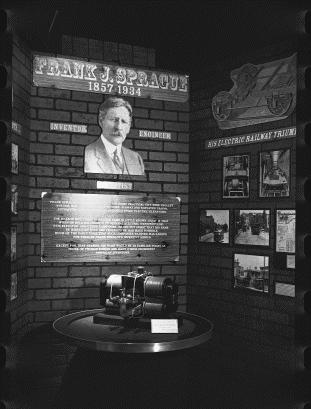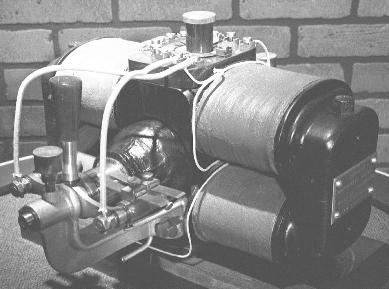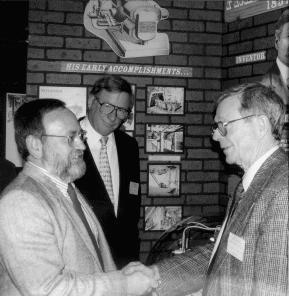
|
|
|
Museum hosts Sprague family reception
 |
| "Frank J. Sprague: Inventor, Scientist, Engineer" |
The museum was honored to receive several dozen descendants
of Frank J. Sprague and their guests at a private reception
on May 15, 1999 for the opening of a new permanent exhibit:
"Frank J. Sprague: Inventor, Scientist, Engineer".
|
The centerpiece of this exhibit is what we believe to be
the oldest surviving Sprague motor. As reported previously,
this motor came to the museum
in the spring of 1998 as part of a donation of artifacts,
photographs and documents made to the museum by the Sprague family.
Exhibits Director Fred Sherwood has spent the last year carefully
restoring the motor and documenting its construction.
The motor in question is not a railway motor. It is a small
industrial motor, constructed by Frank J. Sprague in 1884.
At the time, the use of electrical motors to power industrial
equipment was still experimental. Most equipment, such as looms,
presses, mixers, pumps and conveyors was operated either by
hand power, water power (where the factory was near a body
of moving water) or small stationary steam engines.
The Edison system centralized the energy-producing apparatus at
a large, distant powerplant and distributed the energy as
electricity via wires. Electric motors could be used in
factory/industrial applications, powered by these wires, and
thus obviating the need for a boiler and the attendant heat,
noise and wasted floorspace in each factory.
Frank J. Sprague (1857-1934), a native of Milford, Connecticut,
graduated from the Naval Academy in 1878. After completing
several tours, he signed on with the Thomas Edison's firm in May 1883.
One of Sprague's significant contributions to the Edison Laboratory
was the introduction of mathematical methods. Prior to his arrival,
Edison conducted many costly trial-and-error experiments.
Sprague's approach was to calculate using mathematics the optimum
parameters and thus save much needless tinkering.
Sprague's stay with Edison was brief; in 1884 he left to form the Sprague
Electric Railway and Motor Co.
Sprague's development of his industrial motor was evolutionary,
not revolutionary. He carefully studied the cutting-edge of
motor development and came up with a line of well-engineered
motors that were reliable and efficient. We believe the 1884
motor was a demonstration prototype. If so, it is one of the
motors Sprague brought to the Philadelphia Exposition in the
summer of 1884, a lucrative outing for Sprague, netting several orders.
 |
| The 1884 Sprague motor |
The industrial motor business continued to be very profitable for
Sprague throughout the 1880s, and it was this profit which in effect provided
the R&D funding for him to pursue the study of railway electric
motor applications, eventually leading to what is considered to be
the first commercially successful electric streetcar line in Richmond,
Virgina, 1888. Although the line was a financial success for its
owners, the first to prove more profitable than animal-powered street
railways, Sprague himself lost a considerable amount of money on the deal.
He was unable to meet the deadline specified in the contract because
the trackwork, which was performed by another subcontractor, was shoddy.
Sprague had expected a maximum 8% grade when he, not yet having
seen the Richmond site, negotiated the contract. The actual grades
were higher than 10% however, and the curves were sharp and unguarded.
Sprague's initial equipment was unable to produce enough tractive
effort to function under these conditions, and therefore he was forced
to go back to the drawing board and re-design using double-reduction
gearing. Sprague had to renegotiate the contract down from the initial
$110,000 to $90,000, of which only half was payable in cash, the other
half being stock. Sprague's expenses, increased by the re-engineering
and manufacturing costs, were $160,000, yielding a
cash loss of approximately $115,000, which, in 1999 dollars, would
represent about $1.2 million. Sprague's ongoing success with his
industrial motor business was important in maintaining his financial
solvency during this period.
Sprague continued in the electric railway business for several years and
built several dozen lines. Facing competition from the large and
financially well-equipped Thompson-Houston company, which had purchased
fellow street-railway pioneer Charles Van Depole's firm, Sprague was forced
to sell out to Edison General Electric in 1889. What Sprague perceived
to be a deliberate effort to remove his name from the street railway
division led, in part, to his departure from that company.
Sprague began work on yet another electric motor application: elevators.
Heretofore, elevators had been powered either by steam or
hydraulic systems. Sprague developed a method whereby an electric
motor, mounted at the top of the shaft, directly hoisted and lowered
the elevator car. The operation of this motor was controlled by
a person stationed inside the car. Because the amount of power
needed to run the hoist motor could not feasibly be carried from
the car to the motor via the long "traveler cable", Sprague devised
a remote-control using relays.
A relay is an electrical switch which is operated via an electromagnet.
The movement of the operator's handle in the car supplies the small amount
of power necessary to energize the electromagnet of a relay which is
located near the hoist motor. The relay in turn controls the much larger
amount of power needed to run the motor.
Sprague's first electric elevator installation was in New York City
in 1893. By 1896, he had completed 33 installations, and then
sold his electric elevator business to a consortium of
companies which eventually became Otis Elevator. From his work on
electric elevators, Sprague came upon in 1897 what is considered to be his
most unique and significant invention: multiple-unit control.
Up to that point, all trains were operated with locomotives, which
supplied tractive effort, and trailer cars in which the passengers or
freight were placed. Because they had to pull a train of "dead
weight", locomotives were of necessity large, heavy machines.
In the multiple-unit system, each car of the train carries electric
traction motors. By means of relays energized by train-line wires,
the engineer or motorman commands all of the traction motors in the
train to behave in unison. There is no need for locomotives, so every
car in the train can generate revenue. Furthermore, higher
acceleration and speed are possible as compared to the locomotive system.
Sprague's first multiple-unit order was from the South Side Elevated
in Chicago. John L. Sprague shared a letter with us relating the experiences
of the representative from General Electric, who had also come out
to Chicago to bid on the project. G.E.'s proposal was for an electric
locomotive system, but when Sprague arrived on the scene, G.E. knew
he had them beat with his superior M-U system.
 |
| Chicago South Side El. |
Sprague soon followed with substantial multiple-unit contracts in
Brooklyn and Boston. Quickly, however, competitors General Electric
and Westinghouse both came out with multiple-unit systems.
Sprague waged a successful patent suit in which his controlling patent
was upheld, effectively granting him what we would call today the
intellectual property rights to the multiple-unit idea itself.
Sprague sold his company to General Electric in 1902, and with it the
rights to M-U. He remained a consulting engineer with G.E. into the 1920s.
His activities in the 20th century included the electrification of
the New York Central Railroad, serving on the Naval Consulting Board
during the Great War (W.W. I), work on automatic train control, and
electric signs that could be programmed to display different messages.
Sprague's inventions over 100 years ago
made possible modern "light rail" and rapid transit systems which
still function on the same principles today.
All of this has its roots in the Sprague motor now on display.
These details of the early career of Frank J. Sprague were provided
by Erwin C. Pantel, a member of the museum, who is currently doing his
graduate studies on Frank J. Sprague. Mr. Pantel gave a paper
at the opening, choreographed by slide projectionist and Exhibits Director
Fred Sherwood, on this subject matter.
After the presentation, Mr. John L. Sprague, son of Robert Sprague
and grandson of Frank J. Sprague, shared some letters from his
personal collection on Frank Sprague. Then John joined Peter Sprague,
son of Julian Sprague and grandson of Frank J. Sprague, in cutting
the ribbon and starting the 1884 Sprague motor much to the delight of
all in attendance.
 |
| l-r: F. Sherwood,P. Sprague,J. Sprague |
Three generations of Spragues were present at the opening. For some,
it was their first visit to the museum, while others remembered the
dedication of the Sprague Building in 1959,
made possible by a gift
from Harriet Sprague, the widow of Frank J. Sprague.
Within minutes of the the conclusion of his talk, Mr. Pantel received
offers from several Sprague family members to view additional materials
in their collections in furtherance of his research. The museum's
board and staff look forward to continuing collaboration with the Spragues.




